formerly eScholarship Editions


|
|
|
|
Your search for architecture in text, title, author, description found 929 book(s). | Modify Search | Displaying 41 - 60 of 929 book(s) | |
| 41. | 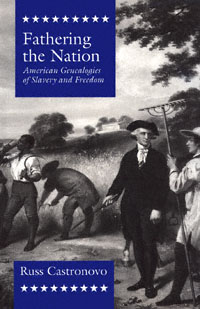 | Title: Fathering the nation: American genealogies of slavery and freedom Author: Castronovo, Russ 1965- Published: University of California Press, 1996 Subjects: Literature | American Literature | Literary Theory and Criticism | American Studies | Postcolonial Studies Publisher's Description: Russ Castronovo underscores the inherent contradictions between America's founding principles of freedom and the reality of slavery in a book that probes mid-nineteenth-century representations of the founding fathers. He finds that rather than being coherent and consensual, narratives of nationhood are inconsistent, ambivalent, and ironic. He examines competing expressions of national memory in a wide range of mid-nineteenth-century artifacts: slave autobiography, classic American fiction, monumental architecture, myths of the Revolution, proslavery writing, and landscape painting.Castronovo theorizes a new American cultural studies which takes into consideration what Toni Morrison calls the "Africanist presence" that permeates American literature. He presents a genealogy that recovers those members of the national family whose status challenges the body politic and its history. The forgotten orphans in Melville's Moby-Dick and Israel Potter , the rebellious slaves in the work of Frederick Douglass and William Wells Brown, the citizens afflicted with amnesia in Lincoln's speeches, and the dispossessed sons in slave narratives all provide dissenting voices that provoke insurrectionary plots and counter-memories. Viewed here as a miscegenation of stories, the narrative of "America" resists being told of an intelligible story of uncontested descent. National identity rests not on rituals of consensus but on repressed legacies of parricide and rebellion. [brief] Matches in book (13): ...Inscribing his separation into the architecture of the past, Brown makes... Similar Items...I want to read and dismantle the architecture of national narrative and examine... ...sprang up in painting, literature, architecture, and biography. The panoramas of... |
| 42. | 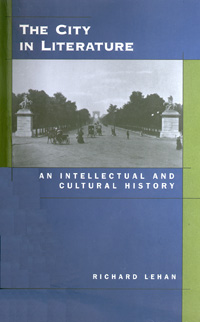 | Title: The city in literature: an intellectual and cultural history Author: Lehan, Richard Daniel 1930- Published: University of California Press, 1998 Subjects: Literature | Urban Studies | Intellectual History | Geography Publisher's Description: This sweeping literary encounter with the Western idea of the city moves from the early novel in England to the apocalyptic cityscapes of Thomas Pynchon. Along the way, Richard Lehan gathers a rich entourage that includes Daniel Defoe, Charles Dickens, Emile Zola, Bram Stoker, Rider Haggard, Joseph Conrad, James Joyce, Theodore Dreiser, F. Scott Fitzgerald, and Raymond Chandler. The European city is read against the decline of feudalism and the rise of empire and totalitarianism; the American city against the phenomenon of the wilderness, the frontier, and the rise of the megalopolis and the decentered, discontinuous city that followed. Throughout this book, Lehan pursues a dialectic of order and disorder, of cities seeking to impose their presence on the surrounding chaos. Rooted in Enlightenment yearnings for reason, his journey goes from east to west, from Europe to America. In the United States, the movement is also westward and terminates in Los Angeles, a kind of land's end of the imagination, in Lehan's words. He charts a narrative continuum full of constructs that "represent" a cycle of hope and despair, of historical optimism and pessimism.Lehan presents sharply etched portrayals of the correlation between rationalism and capitalism; of the rise of the city, the decline of the landed estate, and the formation of the gothic; and of the emergence of the city and the appearance of other genres such as detective narrative and fantasy literature. He also mines disciplines such as urban studies, architecture, economics, and philosophy, uncovering material that makes his study a lively read not only for those interested in literature, but for anyone intrigued by the meanings and mysteries of urban life. [brief] Matches in book (15): ...Frank Lloyd Wrights organic sense of architecture owed much to Jefferson. 3... Similar Items...Space: Toward the Roots of Western Architecture . New York: Von Nostrand, 1992.... ...Bataille, Georges. Against Architecture, translated by Betsy Wing. Cambridge,... |
| 43. | 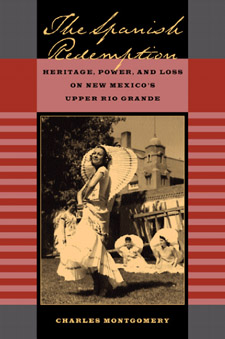 | Title: The Spanish redemption: heritage, power, and loss on New Mexico's upper Rio Grande Author: Montgomery, Charles H 1964- Published: University of California Press, 2002 Subjects: History | United States History | Latino Studies | California and the West Publisher's Description: Charles Montgomery's compelling narrative traces the history of the upper Rio Grande's modern Spanish heritage, showing how Anglos and Hispanos sought to redefine the region's social character by glorifying its Spanish colonial past. This readable book demonstrates that northern New Mexico's twentieth-century Spanish heritage owes as much to the coming of the Santa Fe Railroad in 1880 as to the first Spanish colonial campaign of 1598. As the railroad brought capital and migrants into the region, Anglos posed an unprecedented challenge to Hispano wealth and political power. Yet unlike their counterparts in California and Texas, the Anglo newcomers could not wholly displace their Spanish-speaking rivals. Nor could they segregate themselves or the upper Rio Grande from the image, well-known throughout the Southwest, of the disreputable Mexican. Instead, prominent Anglos and Hispanos found common cause in transcending the region's Mexican character. Turning to colonial symbols of the conquistador, the Franciscan missionary, and the humble Spanish settler, they recast northern New Mexico and its people. [brief] Matches in book (79): ...Architecture and Civilization... Similar Items...Mission Architecture and Colonial Civility, 1904–1920... ...Tourism and Architecture in New Mexico... |
| 44. | 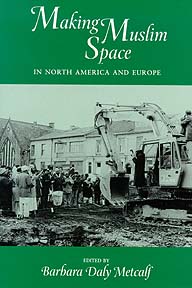 | Title: Making Muslim space in North America and Europe Author: Metcalf, Barbara Daly 1941- Published: University of California Press, 1996 Subjects: Anthropology | History | Islam | Middle Eastern Studies | Postcolonial Studies Publisher's Description: Focusing on the private and public use of space, this volume explores the religious life of the new Muslim communities in North America and Europe. Unlike most studies of immigrant groups, these essays concentrate on cultural practices and expressions of everyday life rather than on the political issues that dominate today's headlines. The authors emphasize the cultural strength and creativity of communities that draw upon Islamic symbols and practices to define "Muslim space" against the background of a non-Muslim environment.The range of perspectives is broad, encompassing middle-class professionals, mosque congregations, factory workers in France and the north of England, itinerant African traders, and prison inmates in New York. The truism that "Islam is a religion of the word" takes on concrete meaning as these disparate communities find ways to elaborate word-centered ritual and to have the visual and aural presence of sacred words in the spaces they inhabit.The volume includes 46 black-and-white photographs that illustrate Muslim populations in Edmonton, Philadelphia, the Green Haven Correction Facility, Manhattan, Marseilles, Berlin, and London, among other places. The focus on space directs attention to the new kinds of boundaries and consciousness that exist not only for these Muslim populations, but for people from all backgrounds in today's ever more integrated world. [brief] Matches in book (76): ...Invisible Architecture: Choreography, Time, and Space... Similar Items...Muslim Space and the Practice of Architecture... ...in British and American Art and Architecture, 1500–1920. New York: Cambridge... |
| 45. | 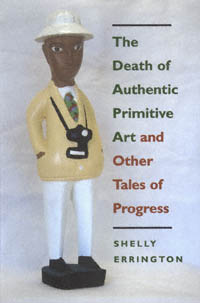 | Title: The death of authentic primitive art and other tales of progress Author: Errington, Shelly 1944- Published: University of California Press, 1998 Subjects: Anthropology | Cultural Anthropology | Art History | Architectural History | Art Theory Publisher's Description: In this lucid, witty, and forceful book, Shelly Errington argues that Primitive Art was invented as a new type of art object at the beginning of the twentieth century but that now, at the century's end, it has died a double but contradictory death. Authenticity and primitivism, both attacked by cultural critics, have died as concepts. At the same time, the penetration of nation-states, the tourist industry, and transnational corporations into regions that formerly produced these artifacts has severely reduced supplies of "primitive art," bringing about a second "death."Errington argues that the construction of the primitive in the nineteenth and twentieth centuries (and the kinds of objects chosen to exemplify it) must be understood as a product of discourses of progress - from the nineteenth-century European narrative of technological progress, to the twentieth-century narrative of modernism, to the late- twentieth-century narrative of the triumph of the free market. In Part One she charts a provocative argument ranging through the worlds of museums, art theorists, mail-order catalogs, boutiques, tourism, and world events, tracing a loosely historical account of the transformations of meanings of primitive art in this century. In Part Two she explores an eclectic collection of public sites in Mexico and Indonesia - a national museum of anthropology, a cultural theme park, an airport, and a ninth-century Buddhist monument (newly refurbished) - to show how the idea of the primitive can be used in the interests of promoting nationalism and economic development.Errington's dissection of discourses about progress and primitivism in the contemporary world is both a lively introduction to anthropological studies of art institutions and a dramatic new contribution to the growing field of cultural studies. [brief] Matches in book (73): ...Hybrid Fantasy Architecture... Similar Items...208 , 210 , 212 hybrid fantasy architecture, 190 -91, 191 , 192 , 193 -94, 226 -... ...colonial exhibit showing typical architecture and artifacts. Often, the natives... |
| 46. | 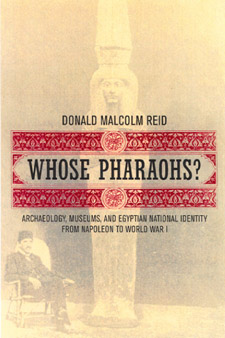 | Title: Whose pharaohs?: archaeology, museums, and Egyptian national identity from Napoleon to World War I Author: Reid, Donald M. (Donald Malcolm) 1940- Published: University of California Press, 2002 Subjects: History | Middle Eastern History | European History | Middle Eastern Studies | Classics | Art History Publisher's Description: Egypt's rich and celebrated ancient past has served many causes throughout history--in both Egypt and the West. Concentrating on the era from Napoleon's conquest and the discovery of the Rosetta Stone to the outbreak of World War I, this book examines the evolution of Egyptian archaeology in the context of Western imperialism and nascent Egyptian nationalism. Traditionally, histories of Egyptian archaeology have celebrated Western discoverers such as Champollion, Mariette, Maspero, and Petrie, while slighting Rifaa al-Tahtawi, Ahmad Kamal, and other Egyptians. This exceptionally well-illustrated and well-researched book writes Egyptians into the history of archaeology and museums in their own country and shows how changing perceptions of the past helped shape ideas of modern national identity. Drawing from rich archival sources in Egypt, the United Kingdom, and France, and from little-known Arabic publications, Reid discusses previously neglected topics in both scholarly Egyptology and the popular "Egyptomania" displayed in world's fairs and Orientalist painting and photography. He also examines the link between archaeology and the rise of the modern tourist industry. This richly detailed narrative discusses not only Western and Egyptian perceptions of pharaonic history and archaeology but also perceptions of Egypt's Greco-Roman, Coptic, and Islamic eras. Throughout this book, Reid demonstrates how the emergence of archaeology affected the interests and self-perceptions of modern Egyptians. In addition to uncovering a wealth of significant new material on the history of archaeology and museums in Egypt, Reid provides a fascinating window on questions of cultural heritage--how it is perceived, constructed, claimed, and contested. [brief] Matches in book (92): ...NEO-ISLAMIC ARCHITECTURE... Similar Items...ORIENTALISM AND ISLAMIC ART, ARCHITECTURE, AND ARCHAEOLOGY-CHAPTER 6... ...classical revival in imperial architecture. Madge Dresser, “Britannia,” in... |
| 47. | 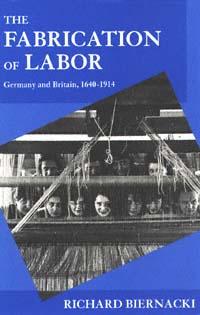 | Title: The fabrication of labor: Germany and Britain, 1640-1914 Author: Biernacki, Richard 1956- Published: University of California Press, 1997 Subjects: History | Sociology | Labor Studies | European History Publisher's Description: This monumental study demonstrates the power of culture to define the meaning of labor. Drawing on massive archival evidence from Britain and Germany, as well as historical evidence from France and Italy, The Fabrication of Labor shows how the very nature of labor as a commodity differed fundamentally in different national contexts. A detailed comparative study of German and British wool textile mills reveals a basic difference in the way labor was understood, even though these industries developed in the same period, used similar machines, and competed in similar markets. These divergent definitions of the essential character of labor as a commodity influenced the entire industrial phenomenon, affecting experiences of industrial work, methods of remuneration, disciplinary techniques, forms of collective action, and even industrial architecture. Starting from a rigorous analysis of detailed archival materials, this study broadens out to analyze the contrasting developmental pathways to wage labor in Western Europe and offers a startling reinterpretation of theories of political economy put forward by Adam Smith and Karl Marx. In his brilliant cross-national study, Richard Biernacki profoundly reorients the analysis of how culture constitutes the very categories of economic life. [brief] Matches in book (7): ...articulate and form a kind of architecture in the agents' minds; rather, it is... Similar Items...Another German manual on industrial architecture, published in 1901, judged that... ...rights to employment, and even mill architecture. The dissimilarities pervaded... |
| 48. | 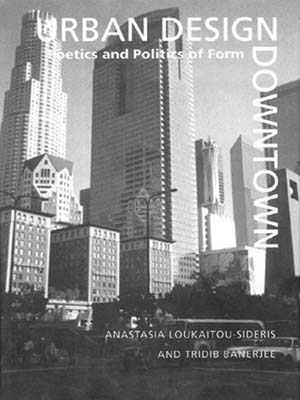 | Title: Urban design downtown: poetics and politics of form Author: Loukaitou-Sideris, Anastasia 1958- Published: University of California Press, 1998 Subjects: Urban Studies | Economics and Business | Social Science | Architecture | Sociology Publisher's Description: The corporate downtown, with its multitude of social dilemmas and contradictions, is the focus of this well-illustrated volume. How are downtown projects conceived, scripted, produced, packaged, and used, and how has all this changed during the twentieth century? The authors of Urban Design Downtown offer a critical appraisal of the emerging appearance of downtown urban form. They explore both the poetics of design and the politics and economics of development decisions.Following a historical review of the various phases of downtown transformation, Anastasia Loukaitou-Sideris and Tridib Banerjee turn to contemporary American downtowns. They examine the phenomenon of public-space privatization, arguing that corporate open spaces are the consumer-oriented result of policies that have promoted downtown renovation and restructuring but at the same time have neglected the cities' existing poverty-stricken cores. The book's case studies of individual West Coast downtown projects capture the essence of late twentieth-century urbanism. This analysis of downtown urban America, which offers extensive insight into the design and development process, will interest architects, city planners, developers, and urban designers everywhere. [brief] Matches in book (78): ...planning, 28 , 283 modernist design/architecture, 24 , 56 -67, 97 , 251 , 278 -... Similar Items...Le Corbusier. 1927. Towards a New Architecture. New York: Payson & Clarke. ——.... ...Models for Public Spaces. Landscape Architecture 78(1): 40-43. ——. 1989. Public... |
| 49. | 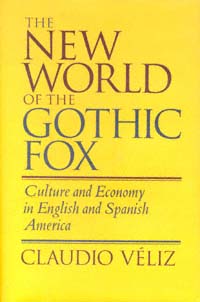 | Title: The New World of the gothic fox: culture and economy in English and Spanish America Author: Véliz, Claudio Published: University of California Press, 1994 Subjects: History | Latin American Studies | Latin American History Publisher's Description: Claudio Véliz adopts the provocative metaphor of foxes and hedgehogs that Isaiah Berlin used to describe opposite types of thinkers. Applying this metaphor to modern culture, economic systems, and the history of the New World, Véliz provides an original and lively approach to understanding the development of English and Spanish America over the past 500 years.According to Véliz, the dominant cultural achievements of Europe's English- and Spanish-speaking peoples have been the Industrial Revolution and the Counter-Reformation, respectively. These overwhelming cultural constructions have strongly influenced the subsequent historical developments of their great cultural outposts in North and South America. The British brought to the New World a stubborn ability to thrive on diversity and change that was entirely consistent with their vernacular Gothic style. The Iberians, by contrast, brought a cultural tradition shaped like a vast baroque dome, a monument to their successful attempt to arrest the changes that threatened their imperial moment.Véliz writes with erudition and wit, using a multitude of sources - historians and classical sociologists, Greek philosophers, today's newspaper sports pages, and modern literature - to support a novel explanation of the prosperity and expanding cultural influence of the gothic fox and the economic and cultural decline endured by the baroque hedgehog. [brief] Matches in book (79): ...Leone Battista. Ten Books on Architecture. Edited by J. Rykwert, English... Similar Items...Blunt, Anthony, ed. Baroque and Rococo: Architecture and Decoration . New York:... ...1948. Bottineau, Yves. Living Architecture: Iberian-American Baroque . English... |
| 50. | 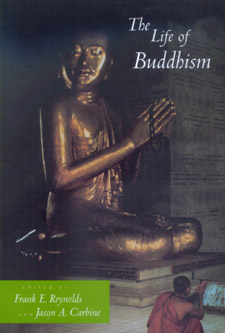 | Title: The life of Buddhism Author: Reynolds, Frank 1930- Published: University of California Press, 2000 Subjects: Religion | Asian Studies | Buddhism Publisher's Description: Bringing together fifteen essays by outstanding Buddhist scholars from Asia, Europe, and North America, this book offers a distinctive portrayal of the "life of Buddhism." The contributors focus on a number of religious practices across the Buddhist world, from Sri Lanka to New York, Japan to Tibet. The essays highlight not so much Buddhist doctrine or sacred texts, but rather the actual behavior and lived experience of Buddhist adherents. A general introduction by Frank E. Reynolds and Jason A. Carbine provides a historical overview and briefly characterizes the three major variants of Buddhist tradition - the Hinayana/Theravada branch practiced in Sri Lanka and much of Southeast Asia; the Mahayana branch located most notably in East Asia; and the Vajrayana/Esoteric branch established in Tibet and Japan. It also takes note of a distinctive form of Buddhism that is now emerging among non-Asian practitioners in the West. The editors introduce each essay with a brief commentary that situates its contents within the Buddhist tradition as a whole. The pieces offer concise depictions and analyses of particular aspects of Buddhist life, including temple architecture and iconography, the consecration of sacred objects, meditative practices, devotional expressions, exorcisms, and pilgrimage journeys. Topics discussed also include the construction of religio-political and religio-social hierarchies, gender roles, the management of asocial behavior, and confrontations with dying and death. [brief] Matches in book (5): ...include such diverse items as temple architecture and iconography, consecration... Similar Items...extant specimens of early Japanese architecture, is more than atoned for by the... ...A great deal of Buddhist art and architecture displays visual images associated... |
| 51. |  | Title: Window shopping: cinema and the postmodern Author: Friedberg, Anne Published: University of California Press, 1993 Subjects: Cinema and Performance Arts | Film | Popular Culture | Women's Studies Publisher's Description: Departing from those who define postmodernism in film merely as a visual style or set of narrative conventions, Anne Friedberg develops the first sustained account of the cinema's role in postmodern culture. She explores the ways in which nineteenth-century visual experiences - photography, urban strolling, panorama and diorama entertainments - anticipate contemporary pleasures provided by cinema, video, shopping malls, and emerging "virtual reality" technologies.Comparing the visual practices of shopping, tourism, and film-viewing, Friedberg identifies the experience of "virtual" mobility through time and space as a key determinant of postmodern cultural identity. Evaluating the theories of Jameson, Lyotard, Baudrillard, and others, she adds critical insights about the role of gender and gender mobility in the configurations of consumer culture.A strikingly original work, Window Shopping challenges many of the existing assumptions about what exactly post modern is. This book marks the emergence of a compelling new voice in the study of contemporary culture. [brief] Matches in book (56): ...Passage Three— Architecture: Looking Forward, Looking Backward... Similar Items...Passage Three— Architecture: Looking Forward, Looking Backward... ...Eugene, 102 ; ill. 78 Atriums. See Architecture: iron and glass Au bonheur des... |
| 52. | 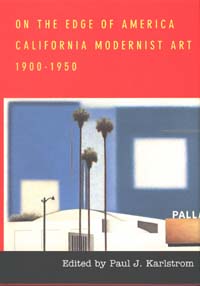 | Title: On the edge of America: California modernist art, 1900-1950 Author: Karlstrom, Paul J Published: University of California Press, 1996 Subjects: Art | Art History | California and the West | United States History | Californian and Western History Publisher's Description: To many, California's social and cultural identity has set it apart from the rest of the nation. Identified almost exclusively with Hollywood and popular culture, the entire region has been denied a meaningful relationship to mainstream twentieth-century modernism. This groundbreaking collection emphatically challenges that assumption. In essays about California art during the first half of the century, the contributors evoke a culture, now recognizable as modernist, that reflects the actual circumstances of contemporary West Coast artistic experience in all its richness. The subjects include painting, murals, sculpture, film, photography, and architecture.The issue of regionalism is central to this remarkable collection. How do we build a cultural portrait of an area that reveals its distinctive character while recognizing its participation in the larger art historical framework? Through the essays runs the theme of an alternative culture that transformed modernism to suit its own regional imperatives. Compelled by a sense of distance and the need for reinvention, California artists created traditions for a new cultural landscape and society. On the Edge of America is an enlightening and visually exciting addition to the growing literature on California art and culture. Through its fresh and expanded view of modernism, it is also well suited to the formulation of a truly national cultural narrative, one that embraces the edges as well as the center of American creative life. [brief] Matches in book (68): ...some splendid things. . . . in architecture here in Los Angeles there are a few... Similar Items...David Gebhard California architecture has enjoyed an international renown since... ...A mention of California and its architecture brings to mind the work in Northern... |
| 53. | 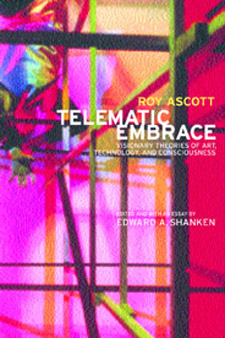 | Title: Telematic embrace: visionary theories of art, technology, and consciousness Author: Ascott, Roy Published: University of California Press, 2003 Subjects: Art | Art Theory | Electronic Media Publisher's Description: Long before e-mail and the Internet permeated society, Roy Ascott, a pioneering British artist and theorist, coined the term "telematic art" to describe the use of online computer networks as an artistic medium. In Telematic Embrace Edward A. Shanken gathers, for the first time, an impressive compilation of more than three decades of Ascott's philosophies on aesthetics, interactivity, and the sense of self and community in the telematic world of cyberspace. This book explores Ascott's ideas on how networked communication has shaped behavior and consciousness within and beyond the realm of what is conventionally defined as art. Telematics, a powerful marriage of computers and telecommunication, made technologies we now take for granted - such as e-mail and automated teller machines (ATMs) - part of our daily life, and made art a more interactive form of expression. Telematic art challenges traditional relationships between artist, artwork, and audience by allowing nonlocal audiences to influence the emergent qualities of the artwork, which consists of the ebb and flow of electronic information. These essays constitute a unique archaeology of ideas, tracing Ascott's meditations on the formation of consciousness through the intertwined cultural histories of art and technology from the 1960s to the present. Shanken's introduction situates Ascott's work within a history of ideas in art, technology, and philosophy. Given the increasing role of the Internet and the World Wide Web in the creation of commerce and community at the dawn of this new millennium, scholars, students, laypeople, policymakers, and artists will find this collection informative and thought-provoking. [brief] Matches in book (77): ...THE ARCHITECTURE OF CYBERCEPTION... Similar Items...pp. 239–40). —Ed. Roy Ascott, "The Architecture of Cyberception" (1994), chapter... ...in some good sense lean towards architecture, which is, of course, the art of... |
| 54. | 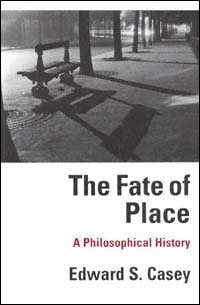 | Title: The fate of place: a philosophical history Author: Casey, Edward S 1939- Published: University of California Press, 1997 Subjects: Philosophy | Classical Philosophy | Architecture | Intellectual History | Geography Publisher's Description: In this imaginative and comprehensive study, Edward Casey, one of the most incisive interpreters of the Continental philosophical tradition, offers a philosophical history of the evolving conceptualizations of place and space in Western thought. Not merely a presentation of the ideas of other philosophers, The Fate of Place is acutely sensitive to silences, absences, and missed opportunities in the complex history of philosophical approaches to space and place. A central theme is the increasing neglect of place in favor of space from the seventh century A.D. onward, amounting to the virtual exclusion of place by the end of the eighteenth century.Casey begins with mythological and religious creation stories and the theories of Plato and Aristotle and then explores the heritage of Neoplatonic, medieval, and Renaissance speculations about space. He presents an impressive history of the birth of modern spatial conceptions in the writings of Newton, Descartes, Leibniz, and Kant and delineates the evolution of twentieth-century phenomenological approaches in the work of Husserl, Merleau-Ponty, Bachelard, and Heidegger. In the book's final section, Casey explores the postmodern theories of Foucault, Derrida, Tschumi, Deleuze and Guattari, and Irigaray. [brief] Matches in book (102): ...to the strictly physical factor in architecture. 161. Ibid. , sec. 10. Derrida... Similar Items...Charles Moore, Body, Memory, and Architecture (New Haven: Yale University Press,... ...textural metaphor as applied to architecture—preferring Deleuze's nomadological... |
| 55. | 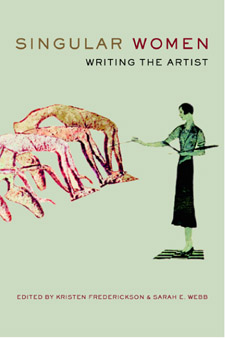 | Title: Singular women: writing the artist Author: Frederickson, Kristen 1965- Published: University of California Press, 2003 Subjects: Art | Art History | Art Criticism | Art Theory | Women's Studies Publisher's Description: In this groundbreaking volume, contemporary art historians - all of them women - probe the dilemmas and complexities of writing about the woman artist, past and present. Singular Women proposes a new feminist investigation of the history of art by considering how a historian's theoretical approach affects the way in which research progresses and stories are told. These thirteen essays on specific artists, from the Renaissance to the present day, address their work and history to examine how each has been inserted into or left out of the history of art. The authors go beyond an analysis of the past to propose new strategies for considering the contributions of women to the visual arts, strategies that take into account the idiosyncratic, personal, and limited rhetoric that confines all writers. [brief] Matches in book (59): ...include women's relationship with architecture as users and patrons and would... Similar Items...Kanes Weisman , eds. The Sex of Architecture. New York : Harry N. Abrams ,... ...Danze, and Carol Henderson . Architecture and Feminism. New York : Princeton... |
| 56. | 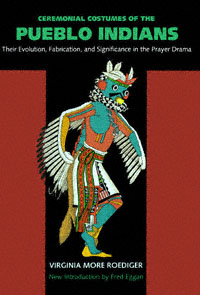 | Title: Ceremonial costumes of the Pueblo Indians: their evolution, fabrication, and significance in the prayer drama Author: Roediger, Virginia More Published: University of California Press, 1991 Subjects: Anthropology | Cultural Anthropology | Dance | Art Publisher's Description: When the University of California Press first published Roediger's Ceremonial Costumes of the Pueblo Indians in 1941, it was immediately hailed as both a beautiful book and the most comprehensive description ever of the making and meaning of the Pueblo costumes of New Mexico and Arizona. It has been widely acknowledged as a classic and eagerly sought after in antiquarian bookstores.Exactly fifty years after its original publication, here is the book back in print, with a new introduction by the renowned anthropologist Fred Eggan. Roediger's vivid paintings are reproduced once more in full color, capturing the beauty and drama of the Pueblo ceremonies - the turquoise dance moccasins, the tableted headdress of the Zuni corn maidens, the bright-blanketed Kachina maiden, and the buffalo, brilliant eagle, and horned deer costumes.It was Roediger who first viewed the ceremony and ritual of the Pueblo peoples as dramatic performance, a view that has gained great currency since. As a student of drama at Yale University she was fascinated by the intensely theatrical dimension to Pueblo worship, and it is this original perspective that informs and illuminates her study.After a brief survey of the history, location, and life of the Pueblo peoples, Roediger embarks on a thorough analysis of the materials used in the Pueblo costumes. She explains both their symbolic significance and their manufacture - from the weaving of cloth and the tanning of leather to the preparation of birds' feathers, evergreens, paints, and dyes. She then provides a meticulous description of the costumed dancer - body paint, garments, ornaments, accessories, and dance properties such as rattles, headdresses, and masks.In her final section, Roediger explores the relation of the costumes to the prayer dramas, particularly to the reverential, solemn, ecstatic public dance with which these climax. Vivid details emerge here about such rituals as the animal dances from the Rio Grande region and the Rain Dance of the Zuni.Fifty years after its original publication, Virginia Roediger's book remains the most comprehensive study of the ceremonial costumes of the Pueblo peoples. A book of great visual appeal and unrivaled detail, it will be welcomed back by scholars and general readers alike. [brief] Matches in book (3): ...Architecture... Similar Items...Architecture... ...for their food supply. Even their architecture is predetermined by the necessity... |
| 57. | 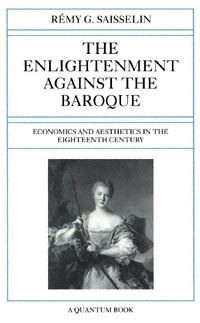 | Title: The Enlightenment against the Baroque: economics and aesthetics in the eighteenth century Author: Saisselin, Rémy G. (Rémy Gilbert) 1925- Published: University of California Press, 1992 Subjects: History | Economics and Business | Popular Culture | Art | Renaissance History Publisher's Description: How do seemingly disparate arenas of Enlightenment philosophy, economic theories, boudoir etiquette, literary styles, and artistic modes coincide in the late eighteenth century? In this poetic essay on the evolution of the idea of luxury and art, Rémy Saisselin uses precise, witty examples to describe the development of our modern taste, ultimately the successor of the more spiritual and grand baroque goût . His analysis both illuminates and distinguishes between eighteenth-century and modern varieties of conspicuous consumption.This persuasive discourse depicts the rise of luxe as an escape from ennui and shows how, for the first time in European history, a large class of wealthy, leisured people emerged to make art, luxury, and the avoidance of boredom its preoccupation. Saisselin provides an original and lucid picture of the first phases in the emergence of a specifically bourgeois taste. [brief] Matches in book (44): ...Gallet, Michel. Paris Domestic Architecture of the Eighteenth Century . London,... Similar Items...Paris, 1972. Braham, Allan. The Architecture of the French Enlightenment .... ...we mean to designate not only the architecture of Bernini and Borromini, or an... |
| 58. | 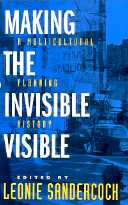 | Title: Making the invisible visible: a multicultural planning history Author: Sandercock, Leonie 1949- Published: University of California Press, 1998 Subjects: Geography | Urban Studies | Sociology | Architecture | Physical Anthropology Publisher's Description: The history of planning is much more, according to these authors, than the recorded progress of planning as a discipline and a profession. These essays counter the mainstream narrative of rational, scientific development with alternative histories that reveal hitherto invisible planning practices and agendas. While the official story of planning celebrates the state and its traditions of city building and regional development, these stories focus on previously unacknowledged actors and the noir side of planning.Through a variety of critical lenses - feminist, postmodern, and postcolonial - the essays examine a broad range of histories relevant to the preservation and planning professions. Some contributors uncover indigenous planning traditions that have been erased from the record: African American and Native American traditions, for example. Other contributors explore new themes: themes of gendered spaces and racist practices, of planning as an ordering tool, a kind of spatial police, of "bodies, cities, and social order" (influenced by Foucault, Lefebvre, and others), and of resistance.This scrutiny of the class, race, gender, ethnic, or ideological biases of ideas and practices inherent in the notion of planning as a modernist social technology clearly points to the inadequacy of modernist planning histories. Making the Invisible Visible redefines planning as the regulation of the physicality, sociality, and spatiality of the city. Its histories provide the foundation of a new, alternative planning paradigm for the multicultural cities of the future. [brief] Matches in book (53): ...Master's thesis, Graduate School of Architecture and Urban Planning, University... Similar Items...Master's thesis, Graduate School of Architecture and Urban Planning, University... ...Frampton, Kenneth. 1980. Modern Architecture: A Critical History. New York:... |
| 59. | 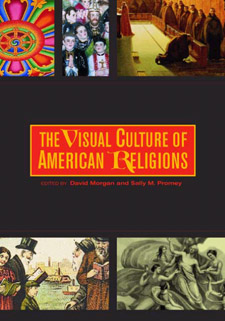 | Title: The visual culture of American religions Author: Morgan, David 1957- Published: University of California Press, 2001 Subjects: Religion | Art | American Studies Publisher's Description: Contemporary artists have often clashed with conservative American evangelicals in recent years, giving the impression that art and religion are fundamentally at odds. Yet historically, artistic images have played a profound role in American religious life. This superb collection of essays, with its unique assembly of images, challenges the apparent tension between religion and the arts by illustrating and investigating their long-standing and intriguing relationship from the early nineteenth century to the present day. The essays explore such varied topics as Sioux Sun Dance artifacts and paintings, American Jewish New Year postcards, the New Mexican santos tradition, roadside shrines, images of journey in African American pictorial traditions, the public display of religion, and the religious use of nineteenth-century technologies of mass reproduction. [brief] Matches in book (63): ...ARCHITECTURE AS COMMUNITY SERVICE... Similar Items...Curl, James Stevens . The Art and Architecture of Free Masonry . Woodstock,... ...Forum on Religion, Art, and Architecture . Exh. cat. Berkeley : Magnes Museum ,... |
| 60. | 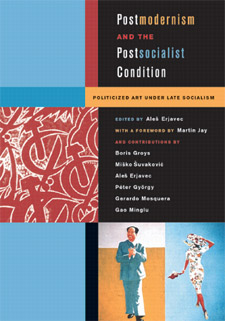 | Title: Postmodernism and the postsocialist condition: politicized art under late socialism Author: Erjavec, Aleš Published: University of California Press, 2003 Subjects: Art | Art History | Art Theory | Intellectual History | Russian and Eastern European Studies Publisher's Description: The Berlin Wall was coming down, the Soviet Union was dissolving, Communist China was well on its way down the capitalist path; the world was witnessing political and social transformations without precedent. Artists, seeing it all firsthand, responded with a revolution of their own. What form this revolution took - how artists in the 1980s marked their societies' traumatic transition from decaying socialism to an insecure future - emerges in this remarkable volume. With in-depth perspectives on art and artists in the former Soviet Union, the Balkans and Mitteleuropa, China, and Cuba - all from scholars and art critics who were players in the tumultuous cultural landscapes they describe - this stunningly illustrated collection captures a singular period in the history of world art, and a critical moment in the cultural and political transition from the last century to our own. Authors Ales Erjavec, Gao Minglu, Boris Groys, Péter György, Gerardo Mosquera, and Misko Suvakovic observe distinct national differences in artistic responses to the social and political challenges of the time. But their essays also reveal a clear pattern in the ways in which artists registered the exhaustion of the socialist vision and absorbed the influence of art movements such as constructivism, pop art, and conceptual art, as well as the provocations of western pop culture. Indebted to but not derived from capitalist postmodernism, the result was a unique version of postsocialist postmodernism, an artistic/political innovation clearly identified and illustrated for the first time in these pages. [brief] Matches in book (49): ...Tibor Szalai, or Abstract Experimental Architecture... Similar Items...Szalai and Istvá n Kotsis, BSCH Architecture, 1984, paper, 120 × 50 × 70 cm.... ...Szalai and István Kotsis, BSCH Architecture, 1984, paper, 120 × 50 × 70 cm.... |